Nocturna was a performance project that took place in Amagansett, New York on September 28th, 2019. It was a collaboration between myself, Jai Hamid Bashir, Eleanor Kipping and her SVA Graduate Class, Amr Sultan, Beau Rhee, Douglas Reiger, Karen Flatow and her Family, and The Making Without Objects class at Columbia University.
We danced, painted, and we made music and theater for each other. We were trying to make what we thought of as a "conversation" held through our favorite things to do. So, I would begin a painting, which Jai would see, and it would influence her writing. Then I'd read her poem, and it would influence my painting. We did this over the summer, and tried to scale up our dialogue by inviting others into the mix, to make what they wanted to. We'd try to find a way to put it all together for a "play," in the fall. It was a nebulous, unfocused project from the start.
Eventually, the "play" that happened, was organized around both a series of musical tracks made by Amr, and a series of spaces in the rather sprawling venue, at what was then CrushCURATORIAL, Amagansett in the Hamptons. There was dancing. Characters came and went, sometimes concentrating in one place, sometimes dispersing across multiple locations of activity or interest. Some characters appeared to be part of the crowd, but came and went between it, interacting with other performers and with guests. There were many rituals. The project became heavily invested in magical thinking and pretend as ways to contend with our environment. I don't think we destroyed, or fixed, anything. It lasted about an hour and half, was loosely based on The Odyssey, and ended with a feast. As any good ritual should.
I'm sure I haven't described it terribly well. So, to help relate the mood of the project, below are: some sparse documentation of the event, along with excerpts from the invitation Jai and I assembled to bring other collaborators into the project, and a transcript from a meeting in which we discuss what we think we were doing. I hope it helps.
Performance photos and video credited to Isabelle Hogenkamp, Ashby Marie Bland, David Lenz, Erin Elise Holland, and Patrick Bayly.
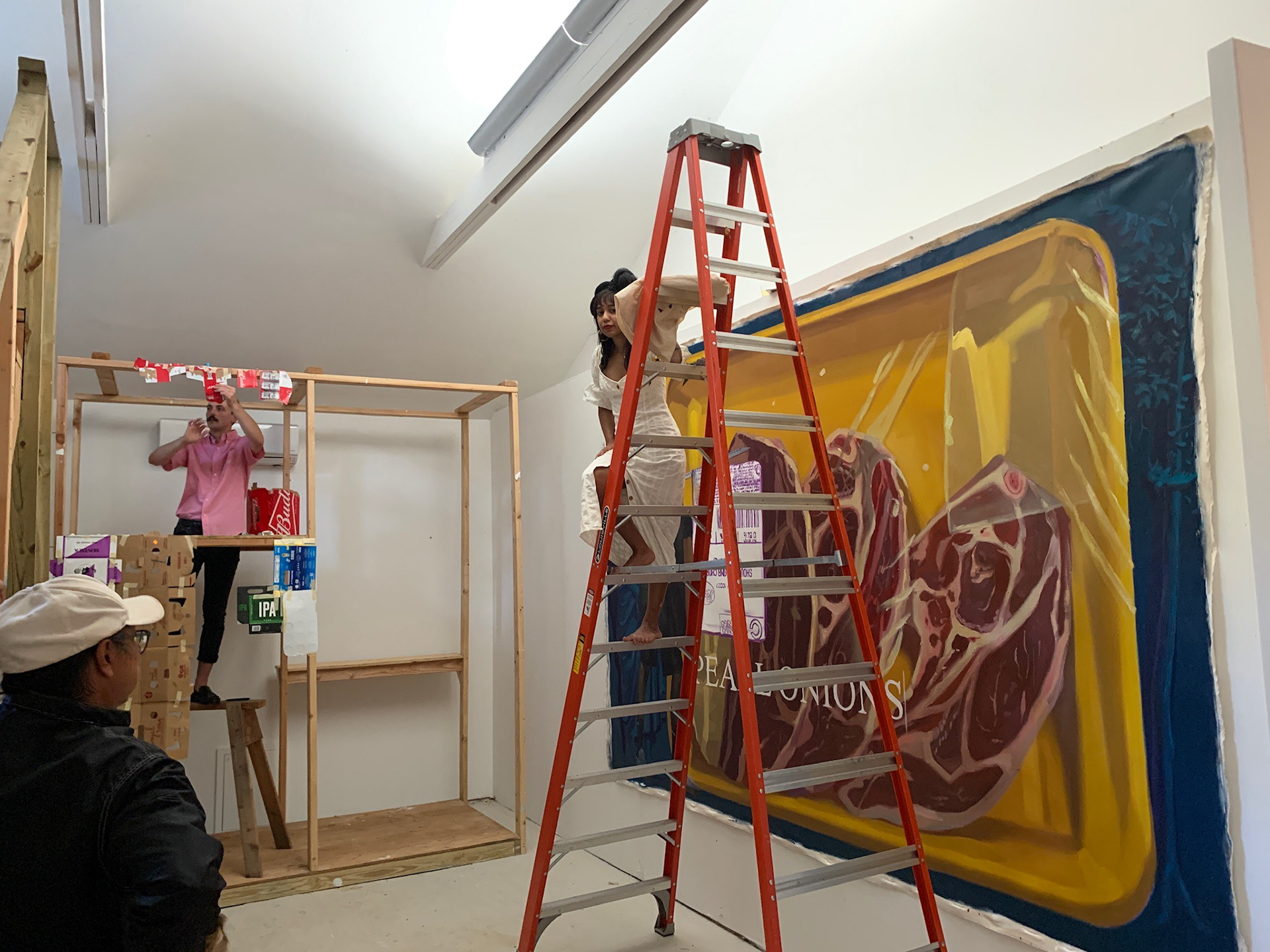
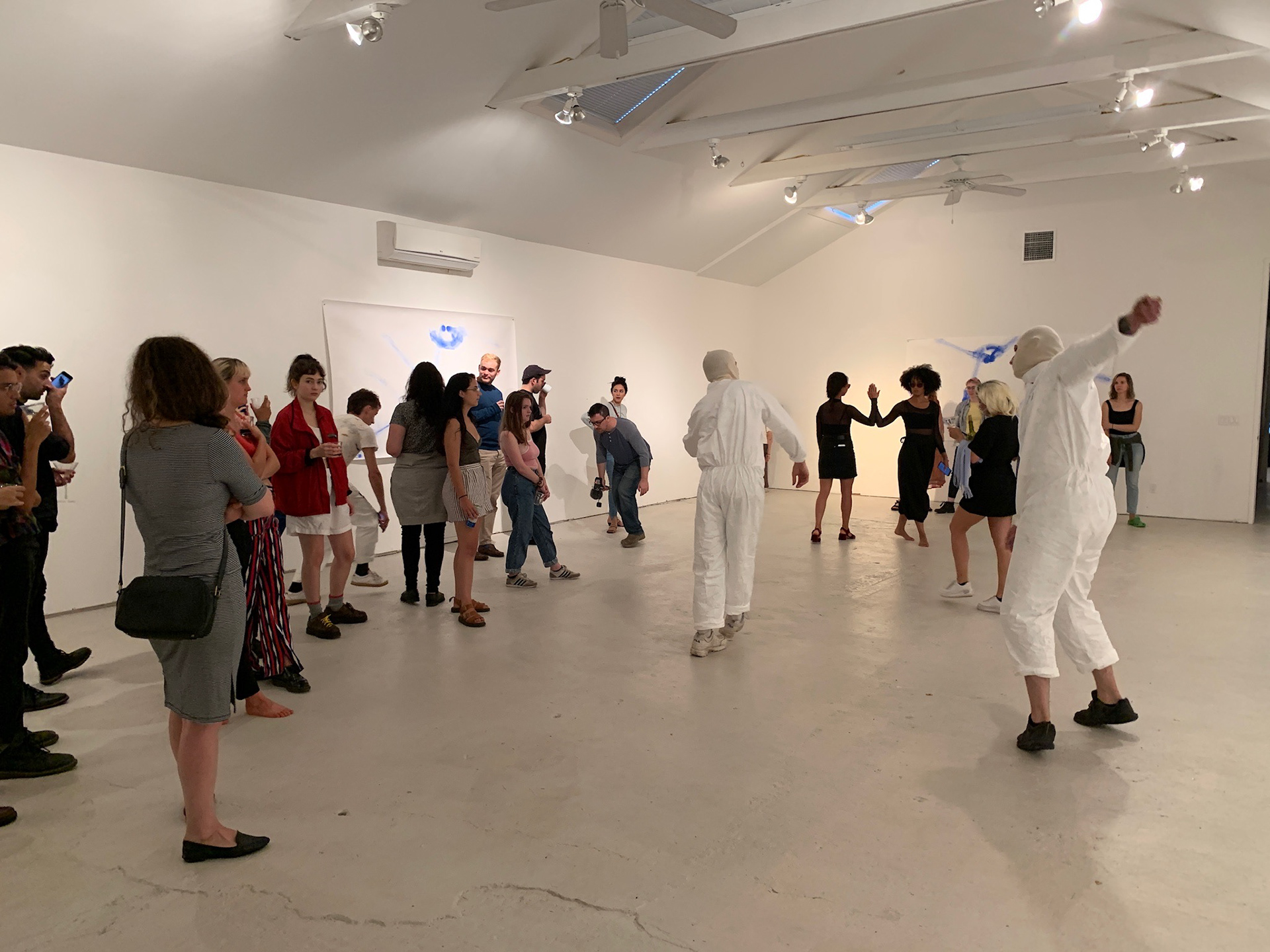
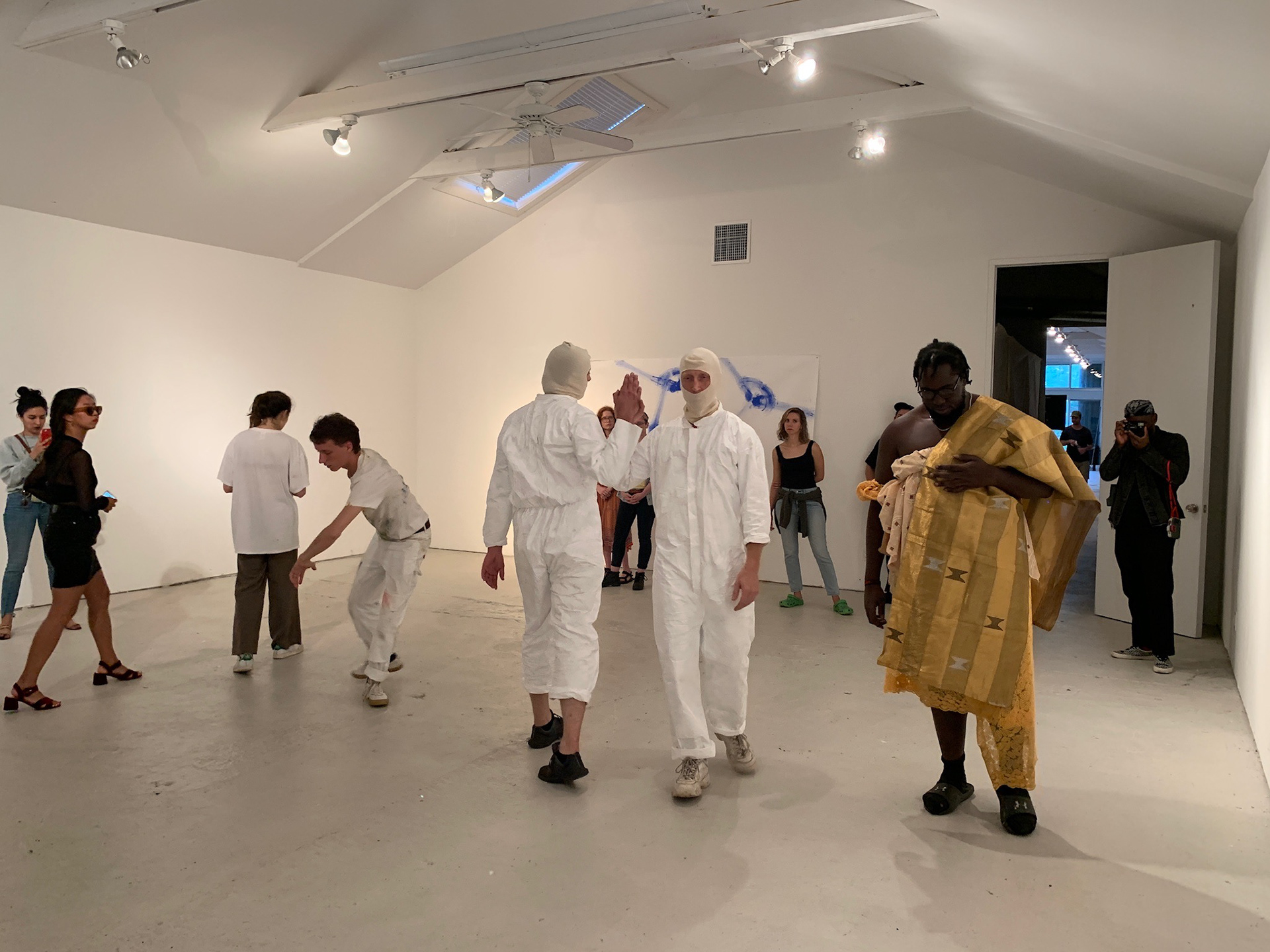
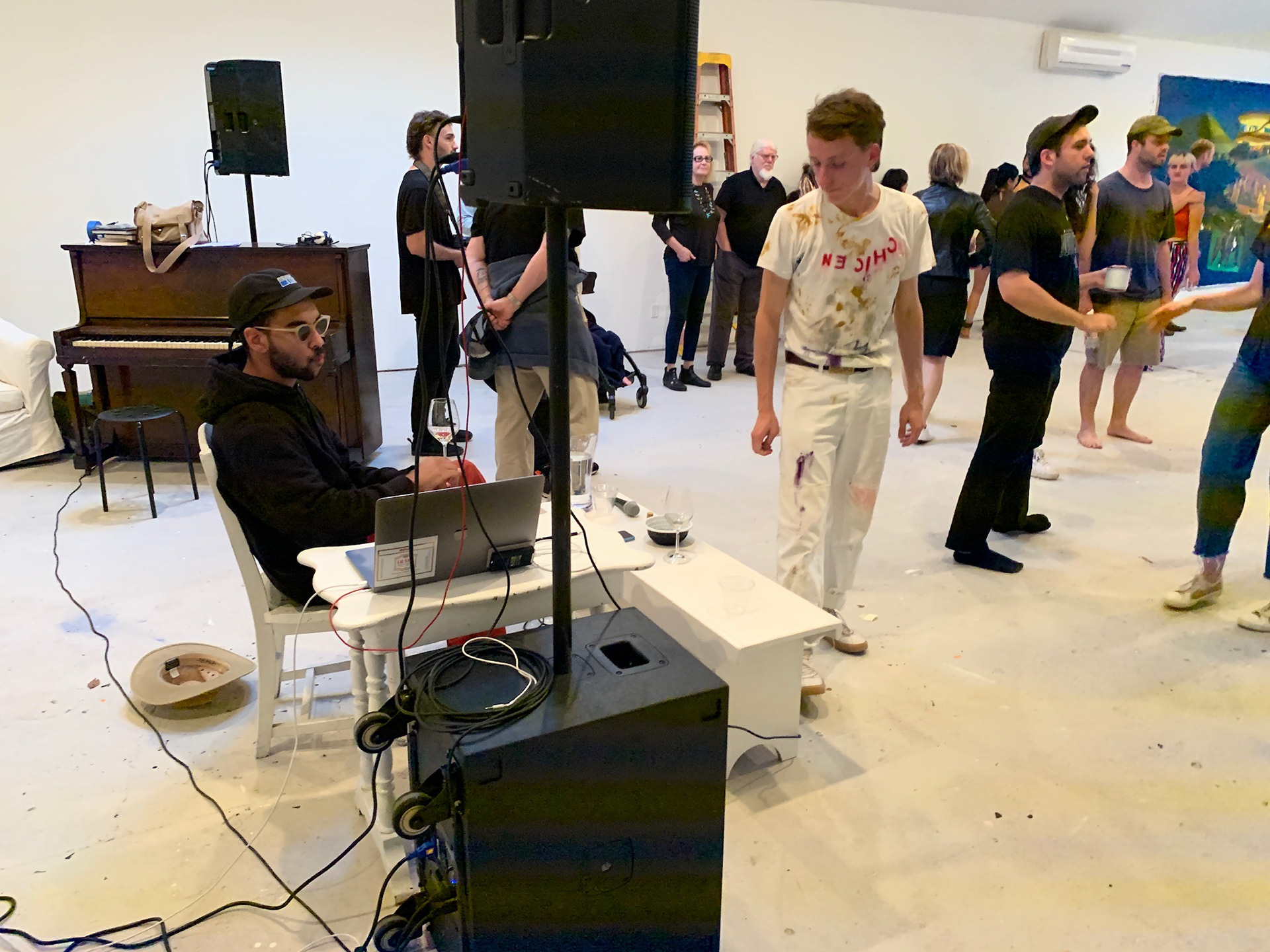
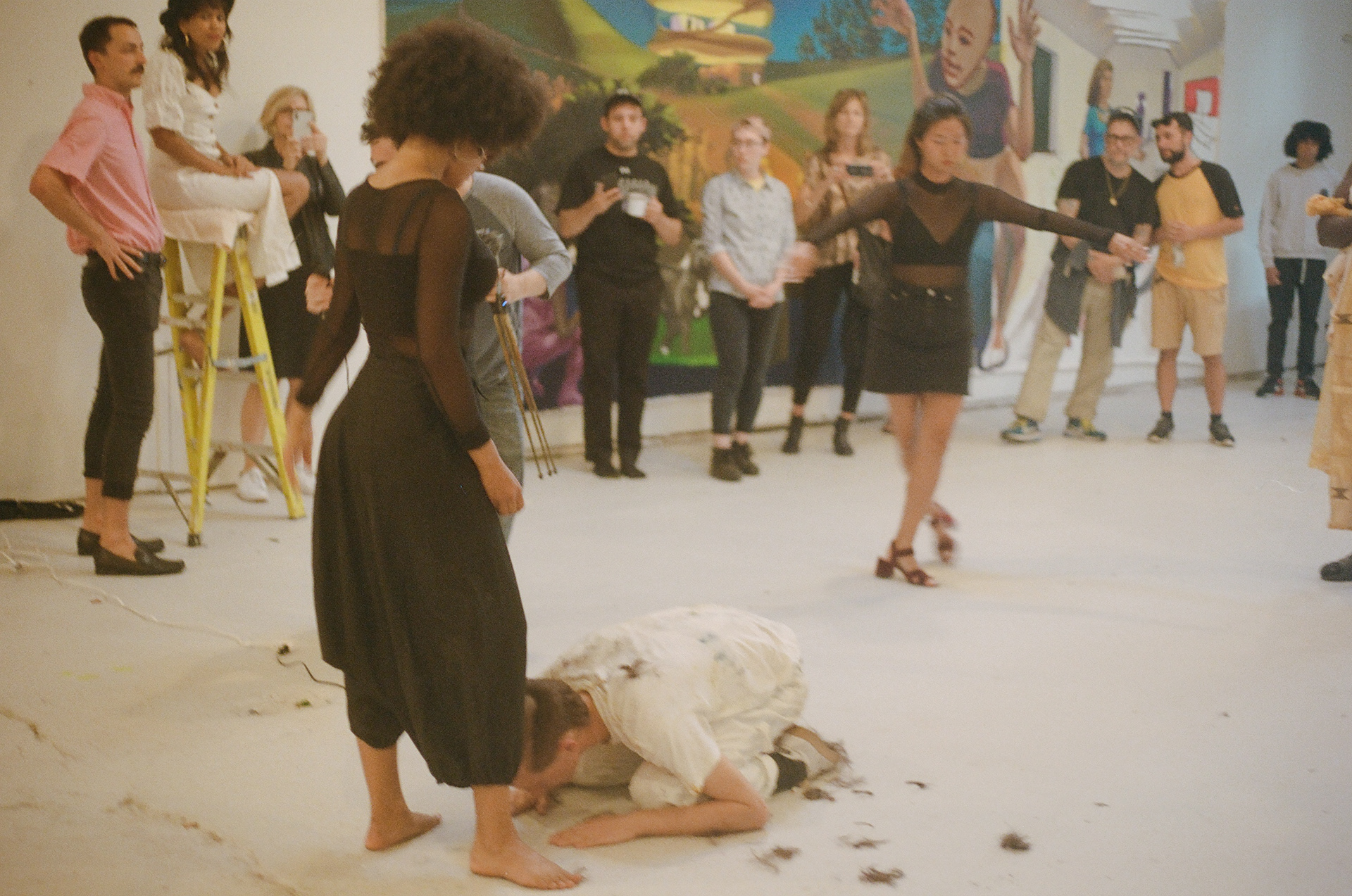
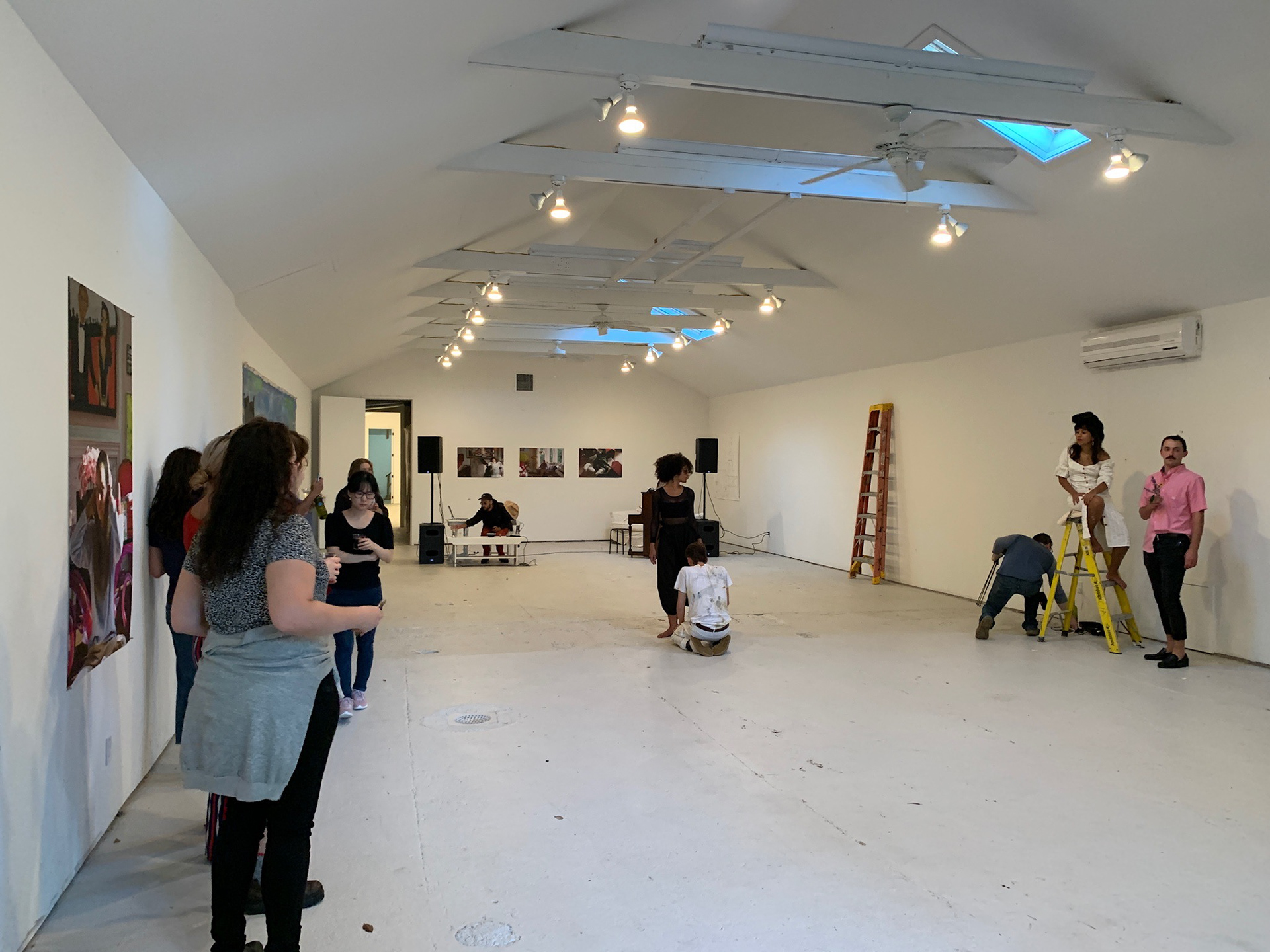
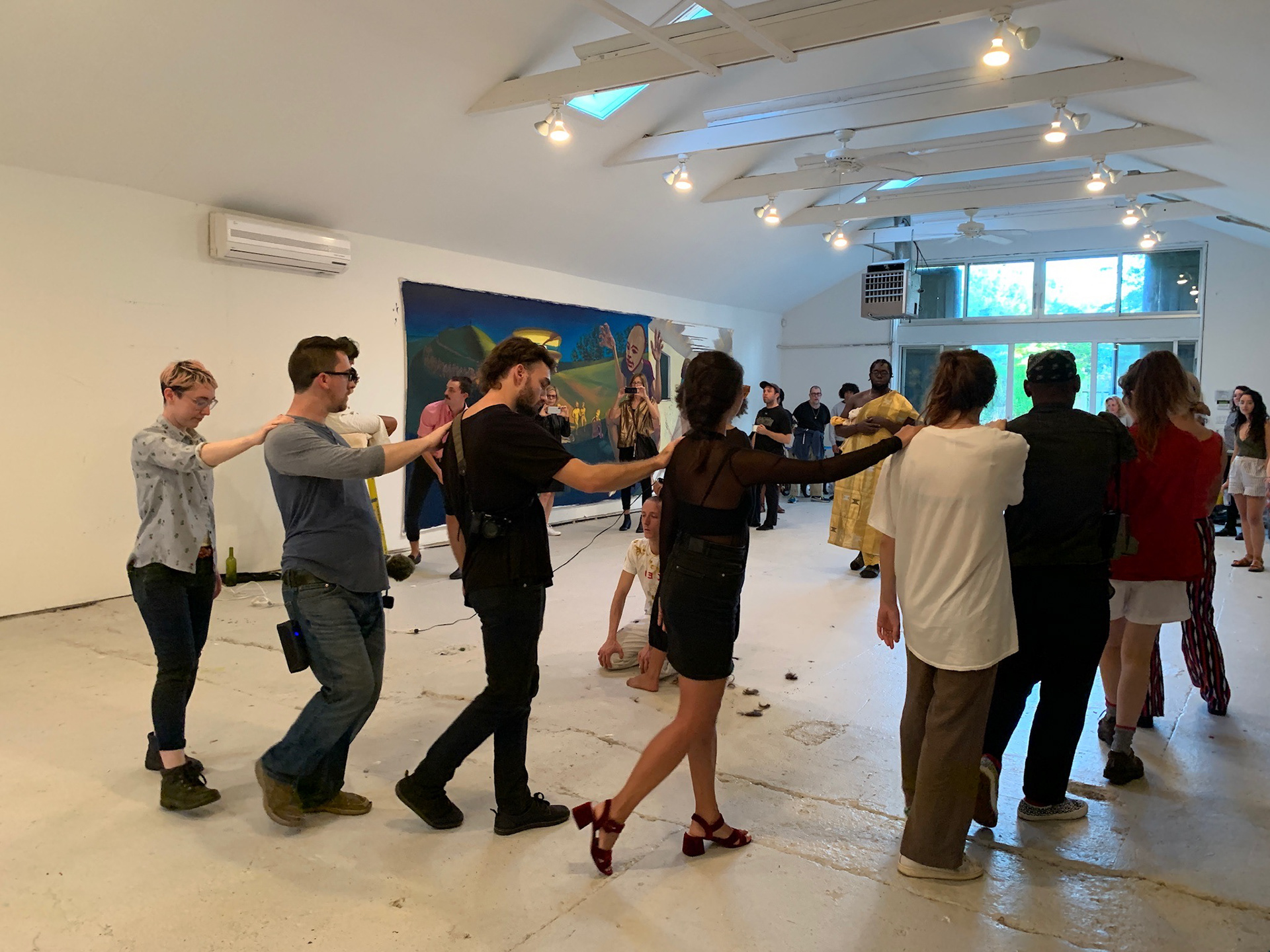
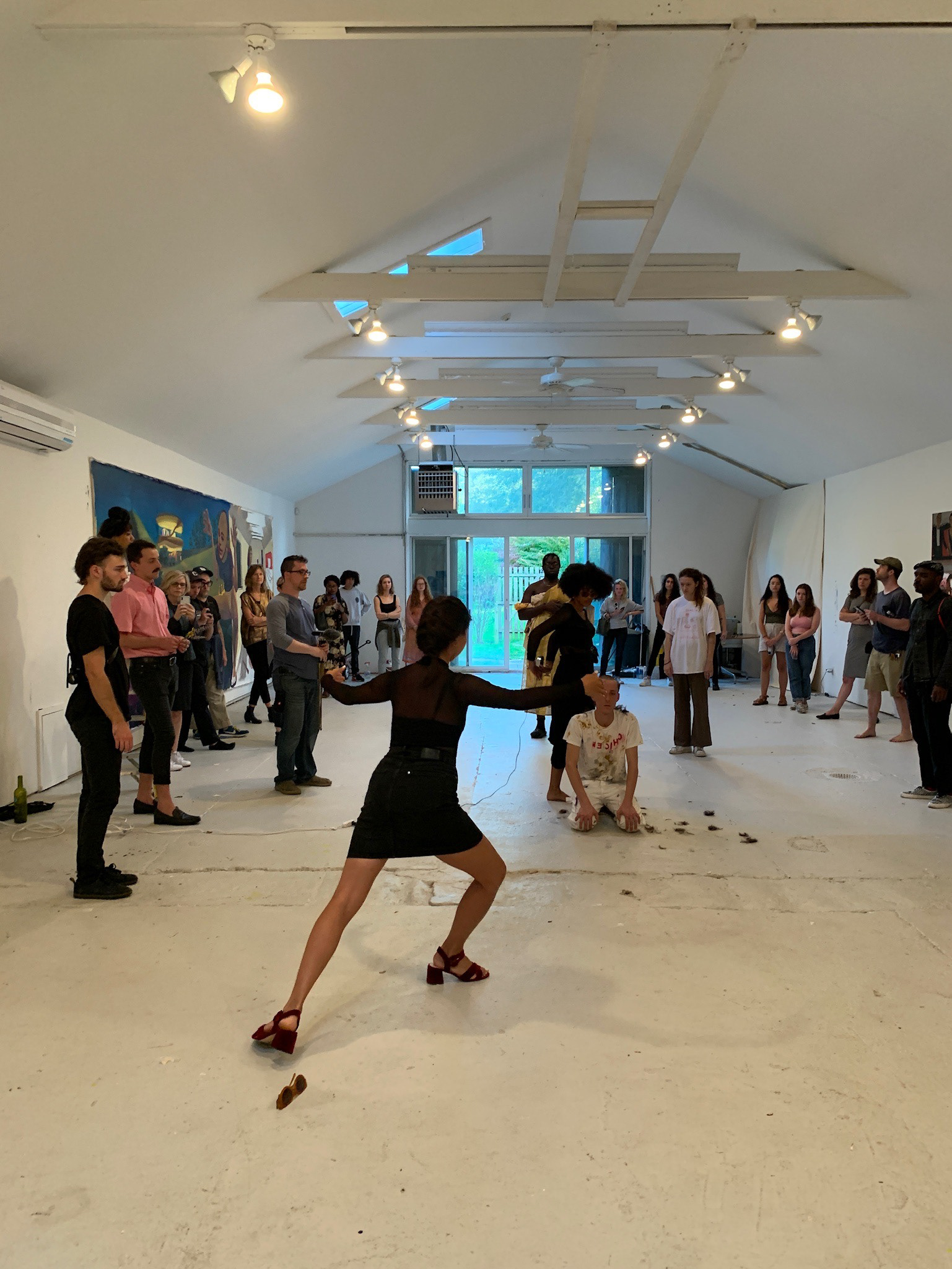
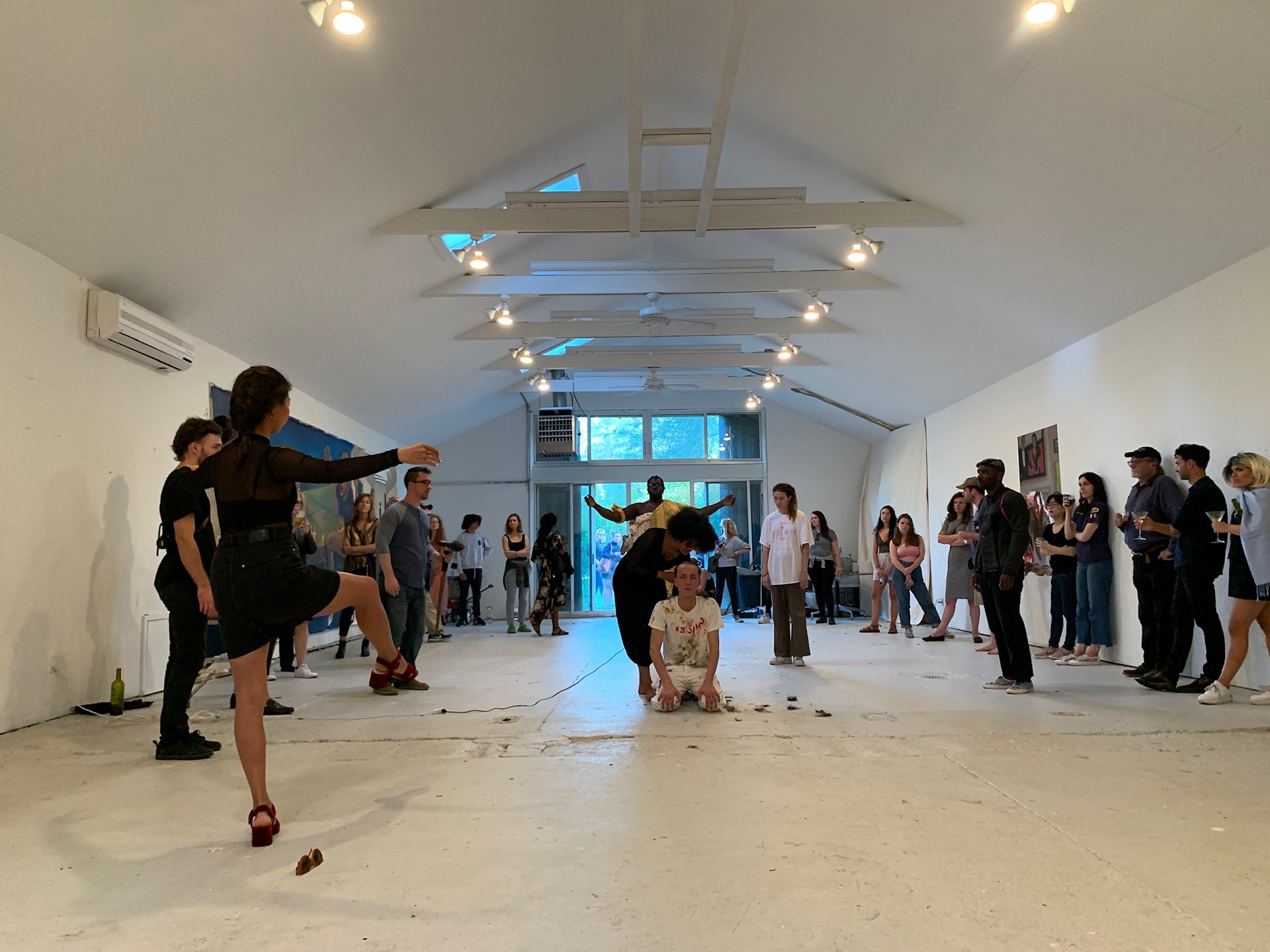

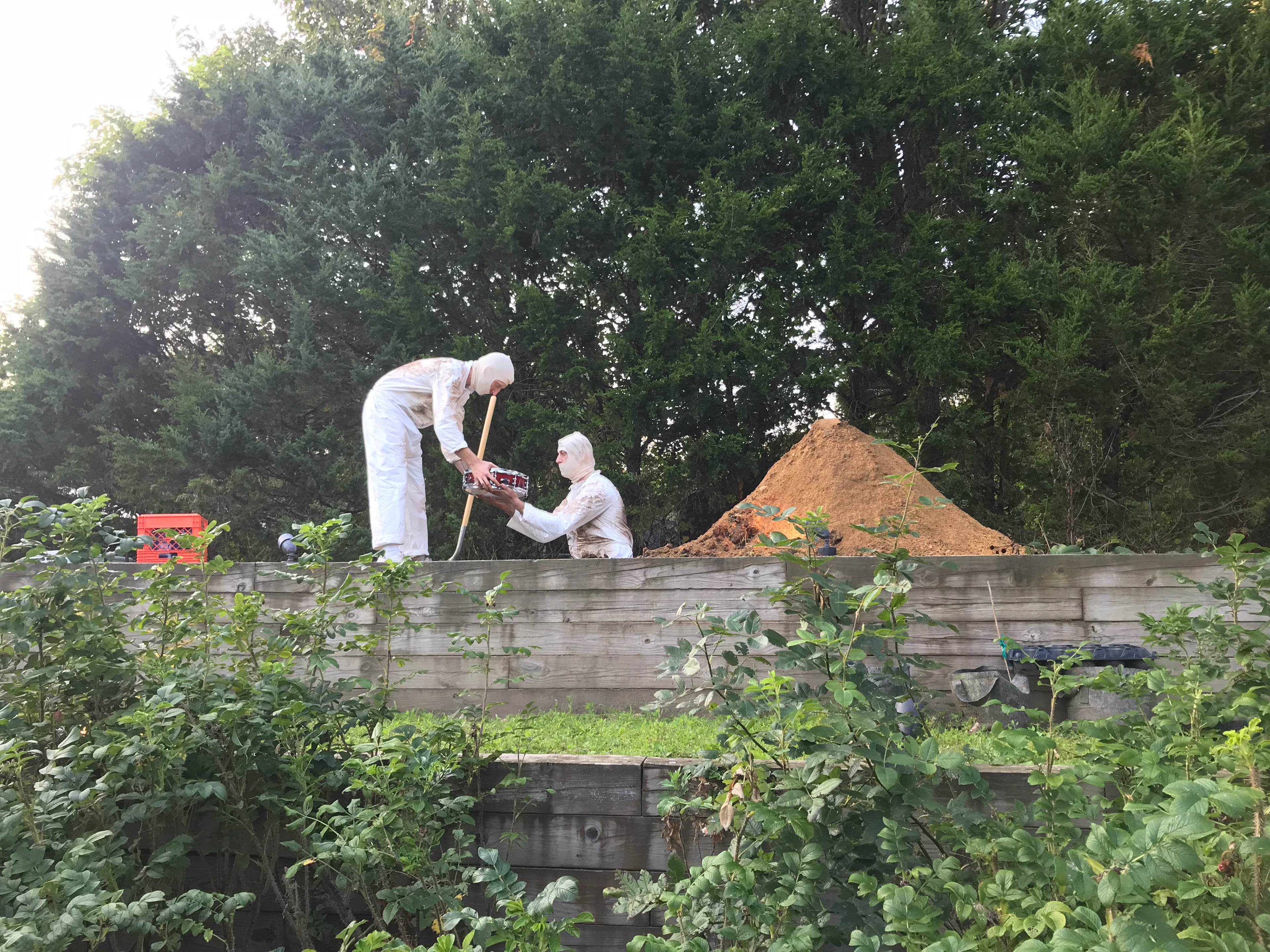
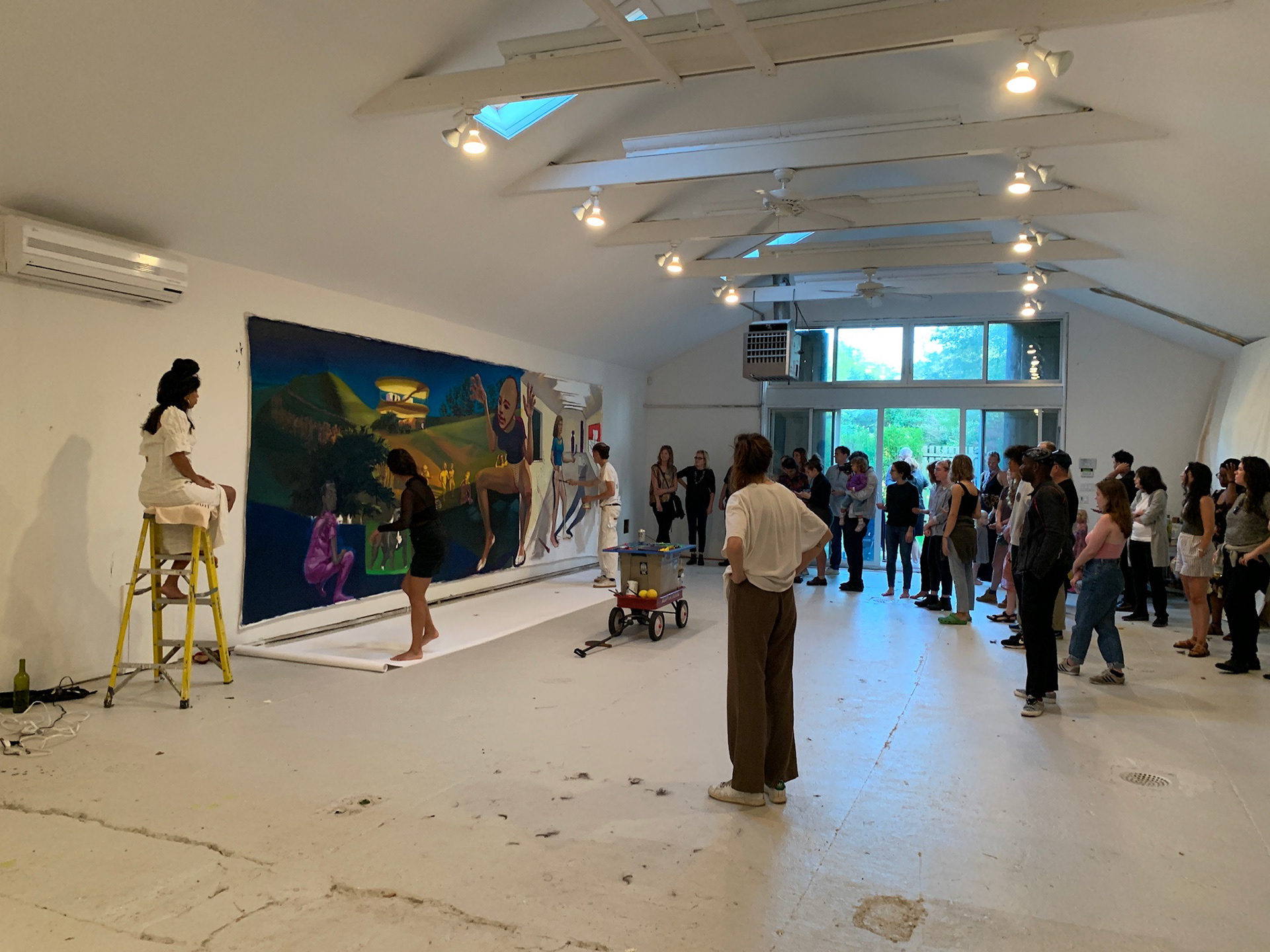
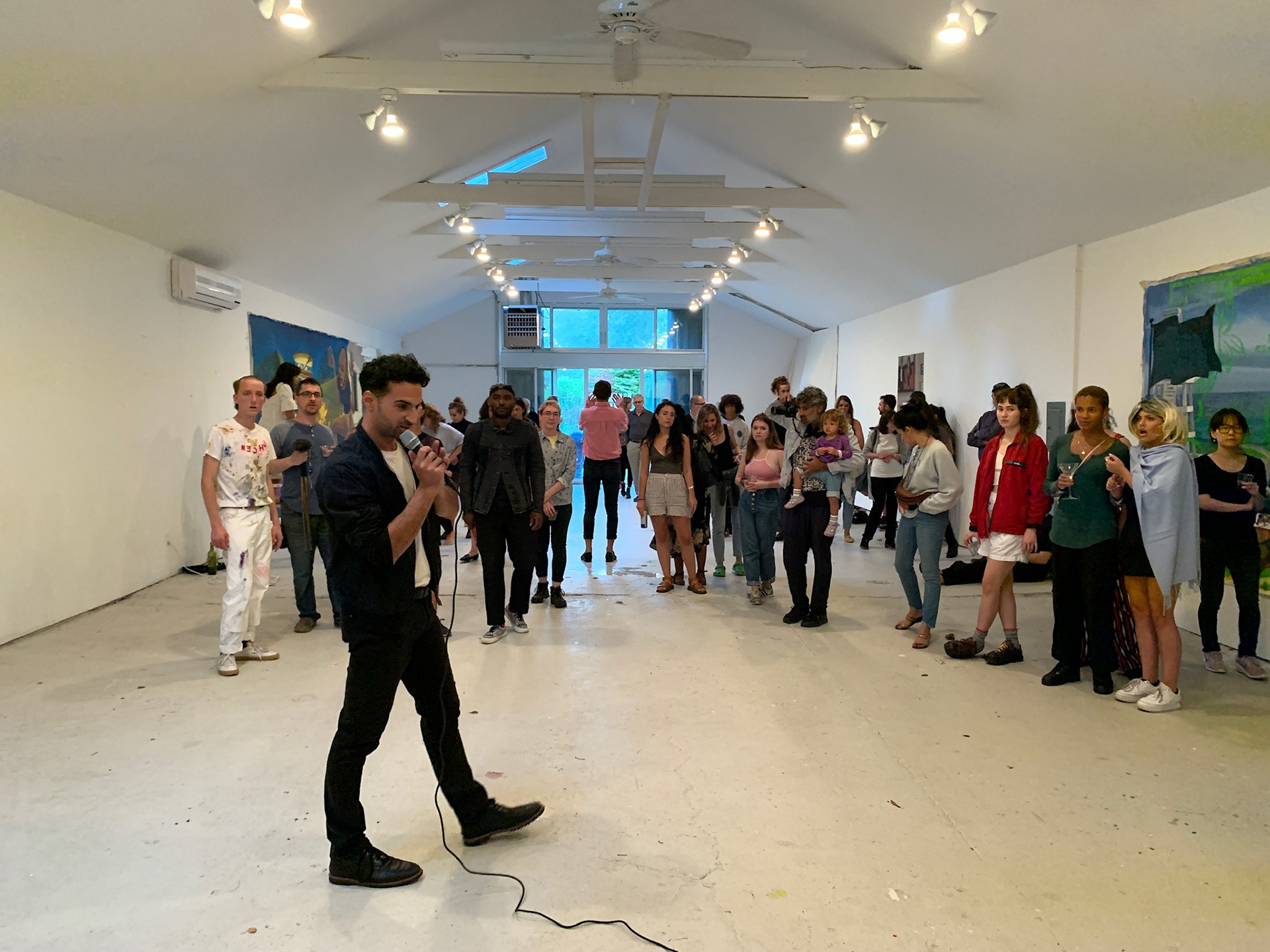
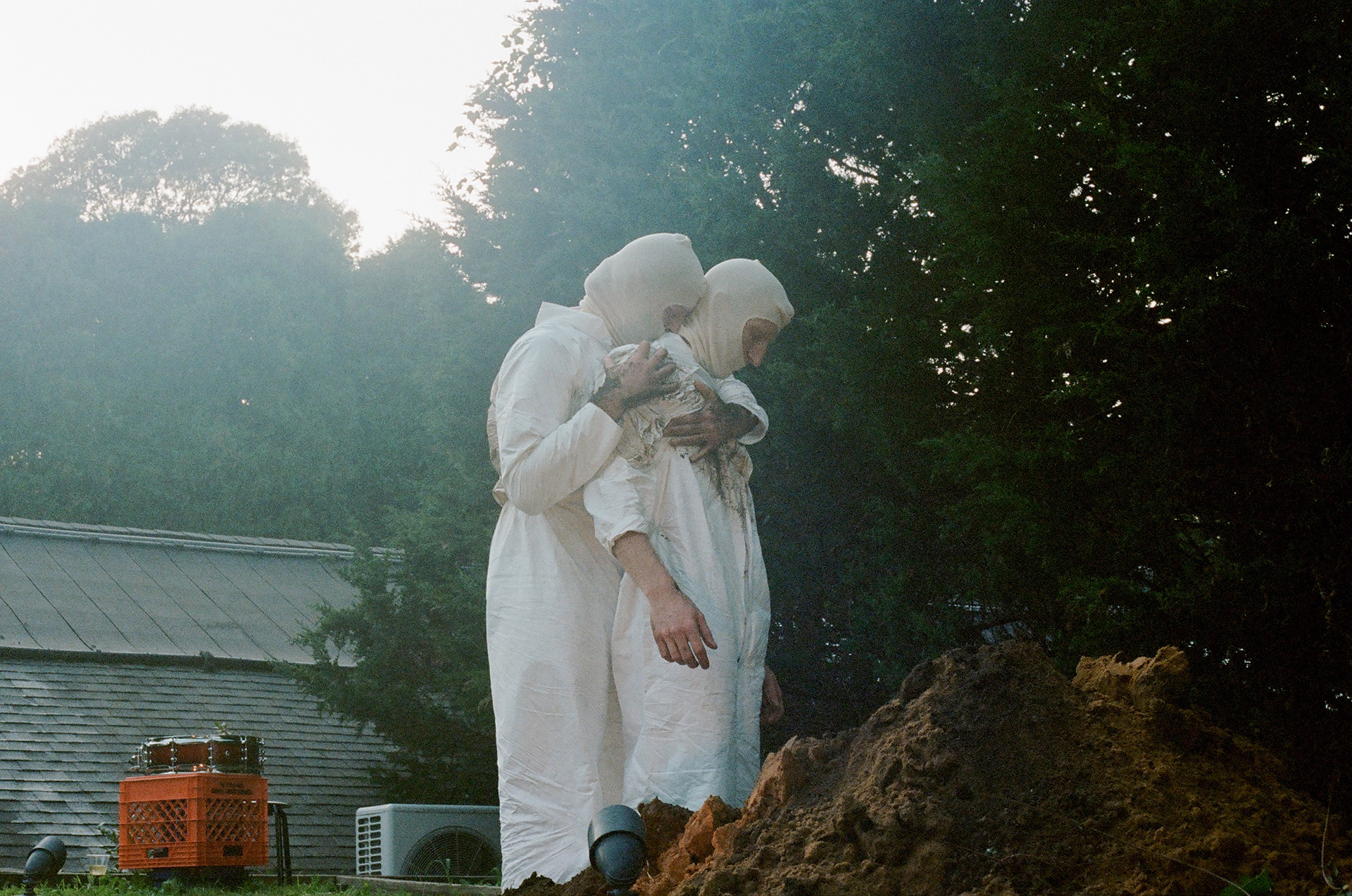
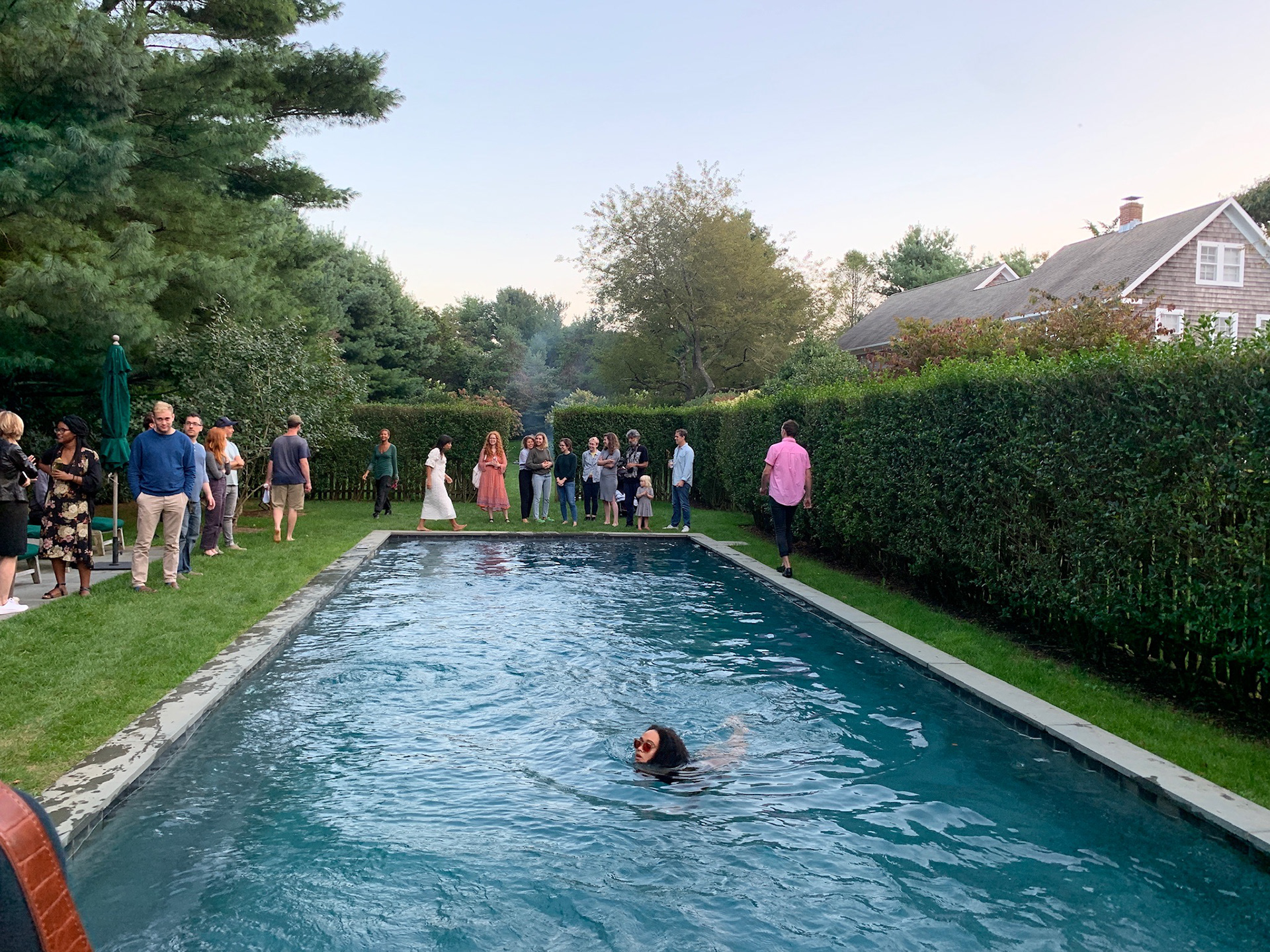
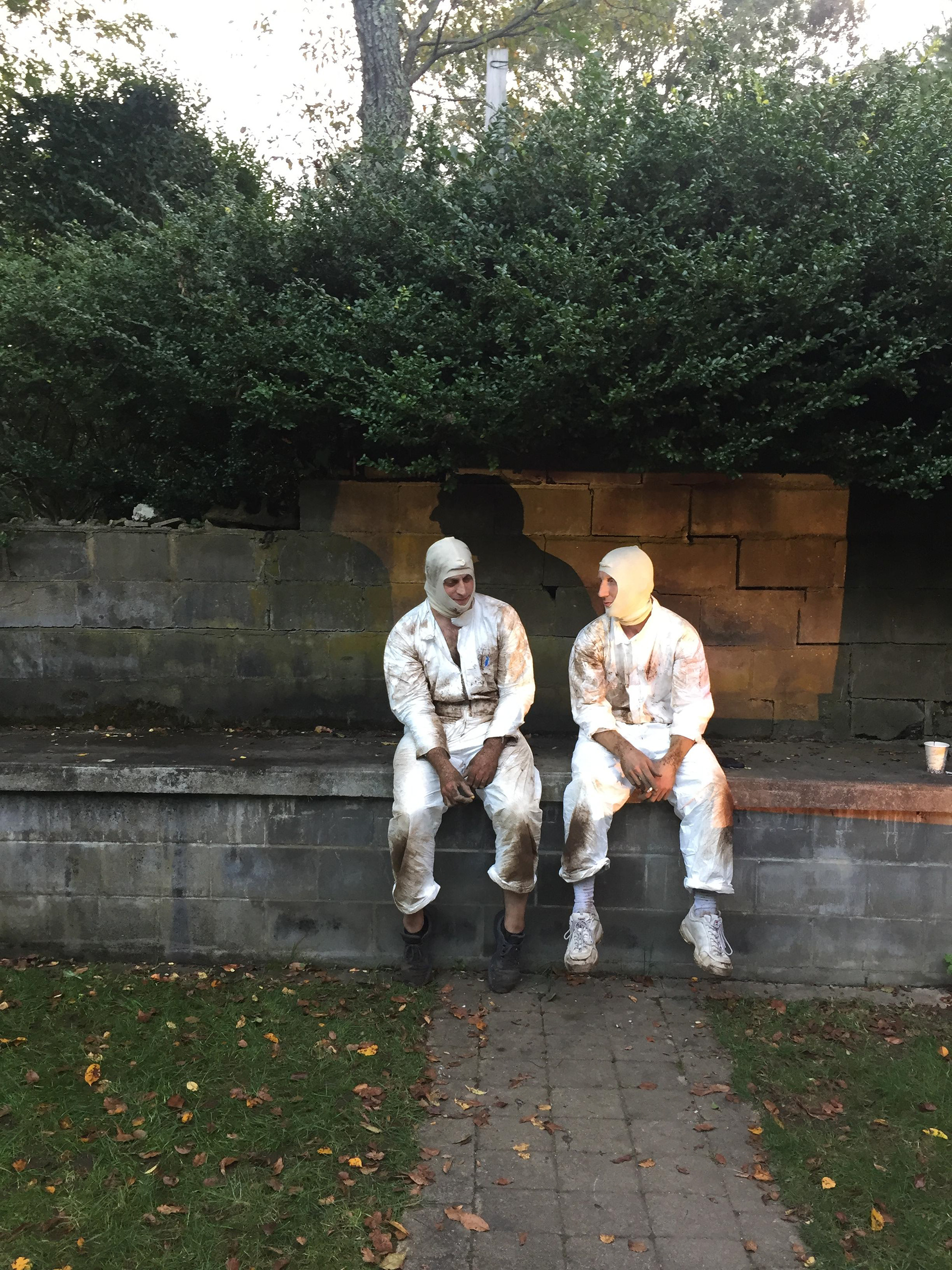
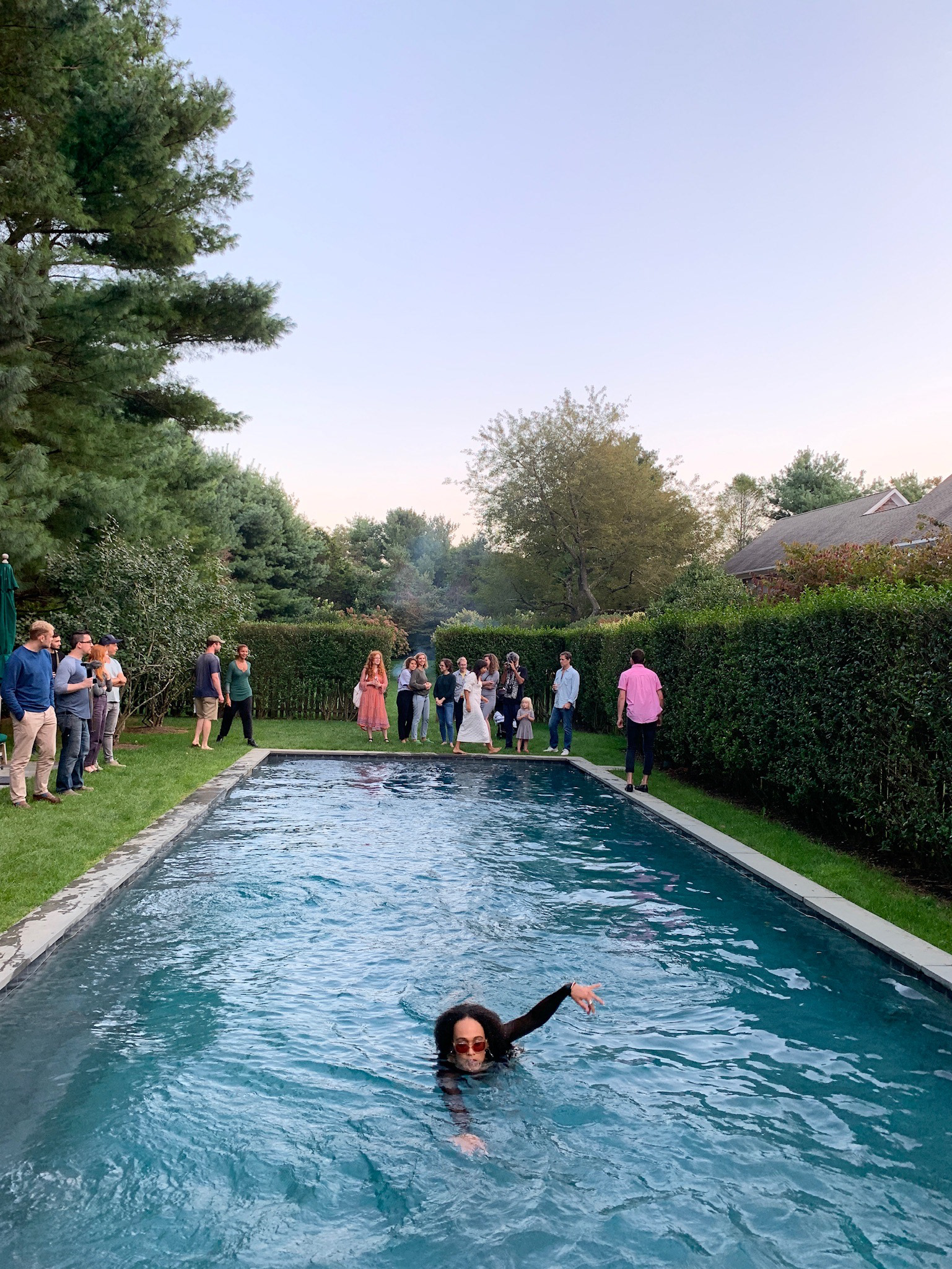
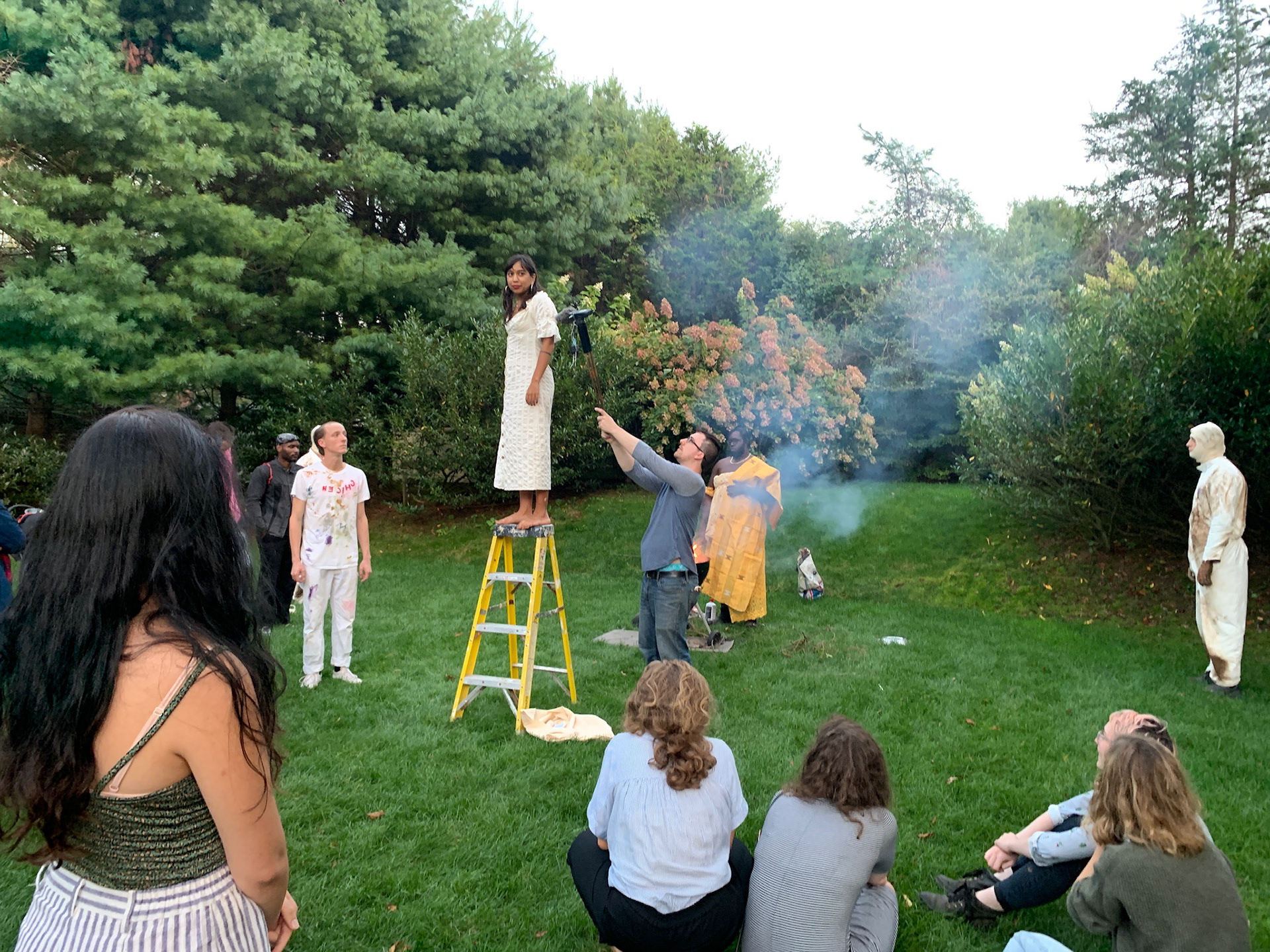
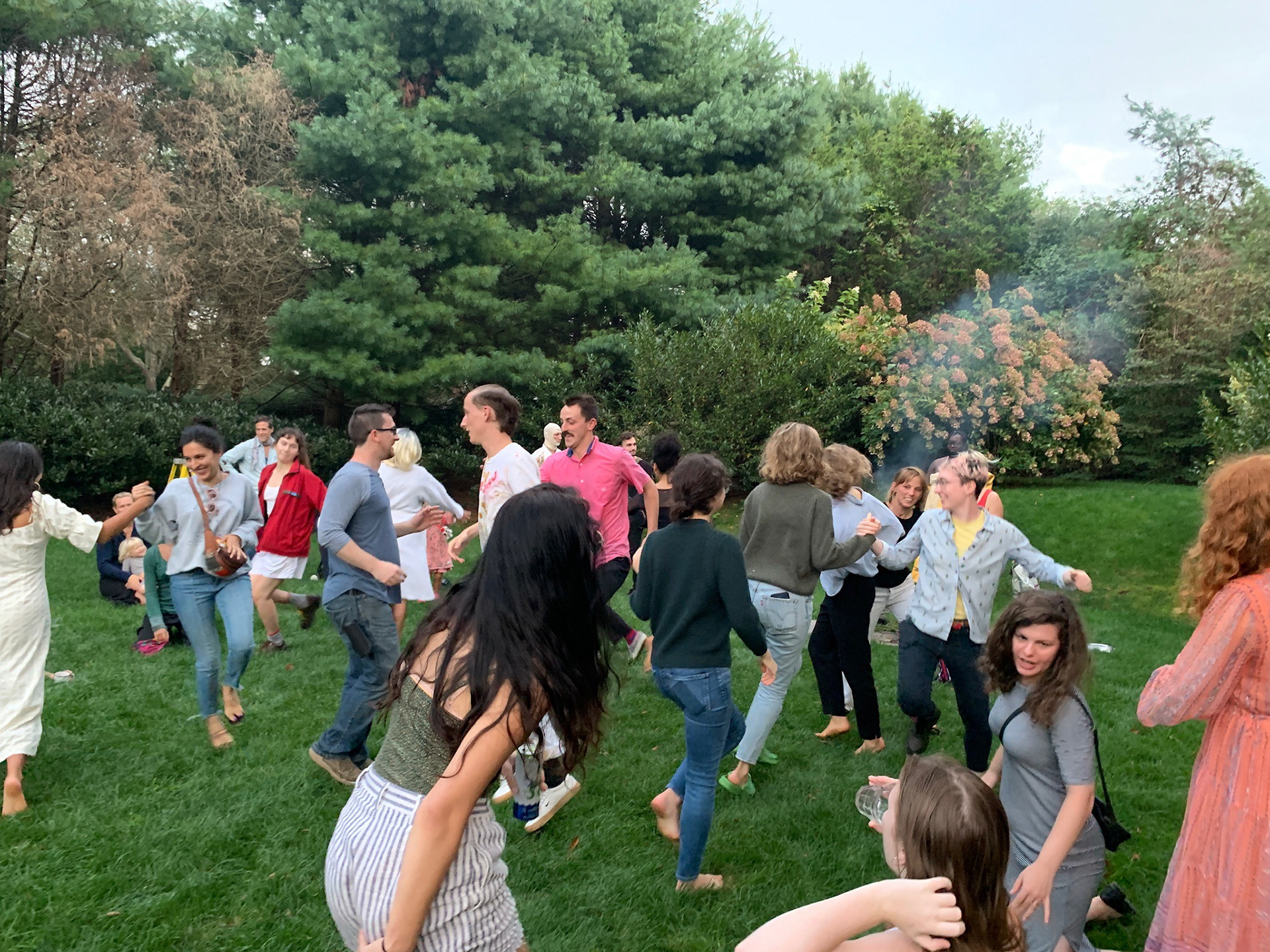
Spirits (Dylan Languell and Douglas Reiger) dig a pit to bury a snare drum on a terrace overlooking the estate.
Nocturna (Eleanor Kipping), shaves a bald spot into the Painter (Patrick Bayly) as an offering, while the Oracle (Jai Hamid Bashir) looks on from her ladder. A troupe of dancers led by the Priestess (Beau Rhee) circles, and Osiris (Farouk Oni) looks on. Music by Amr Sultan.
Overpainting The Hamptons after head shaving.
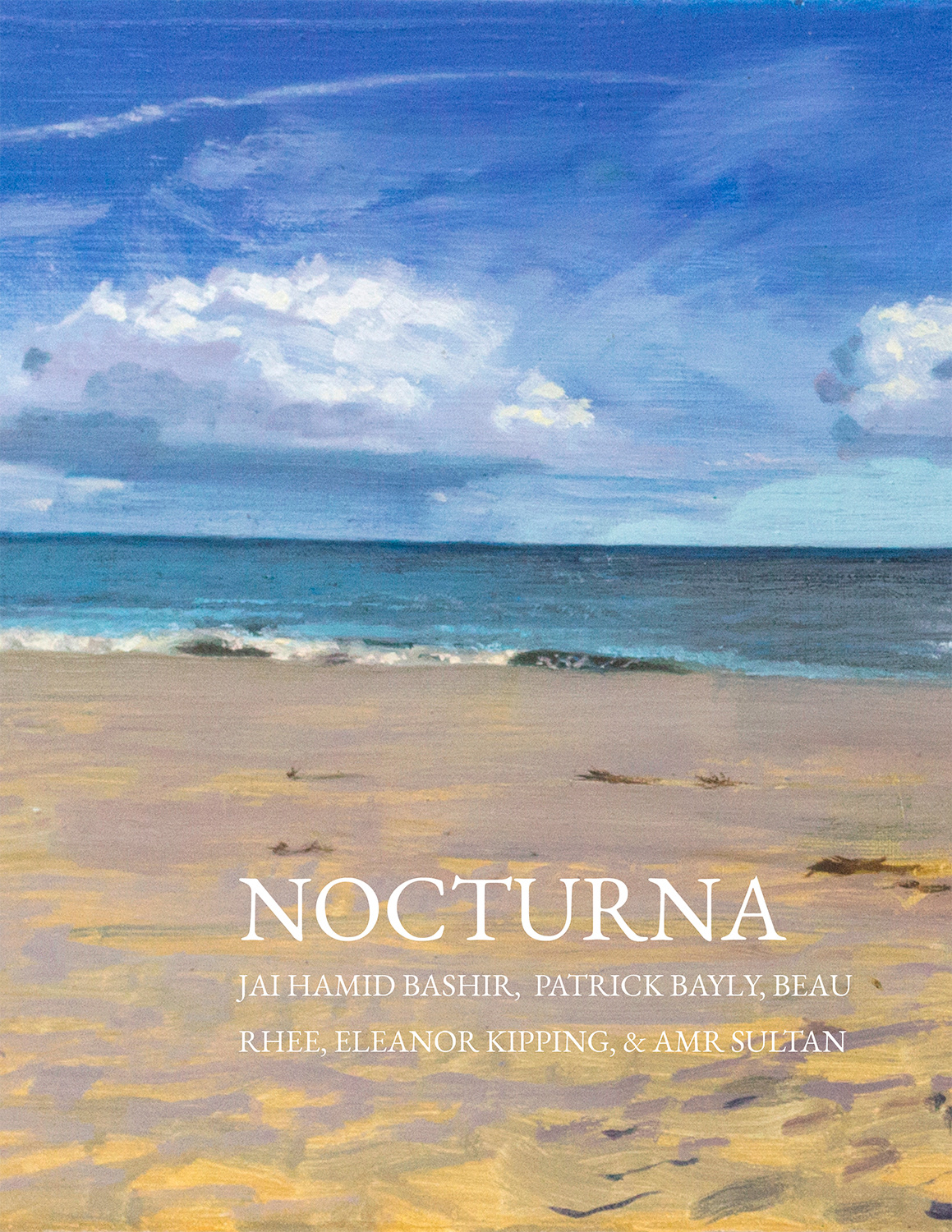
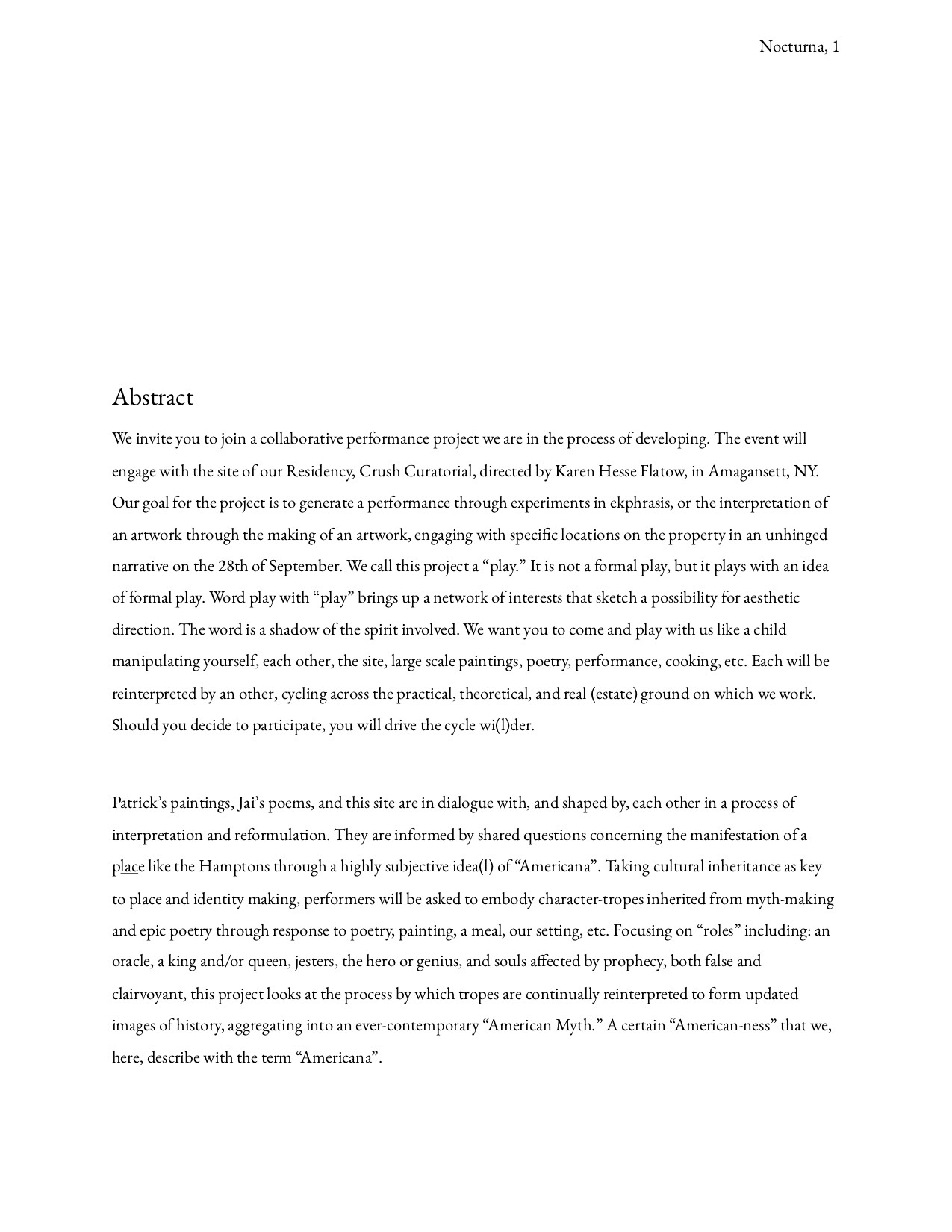
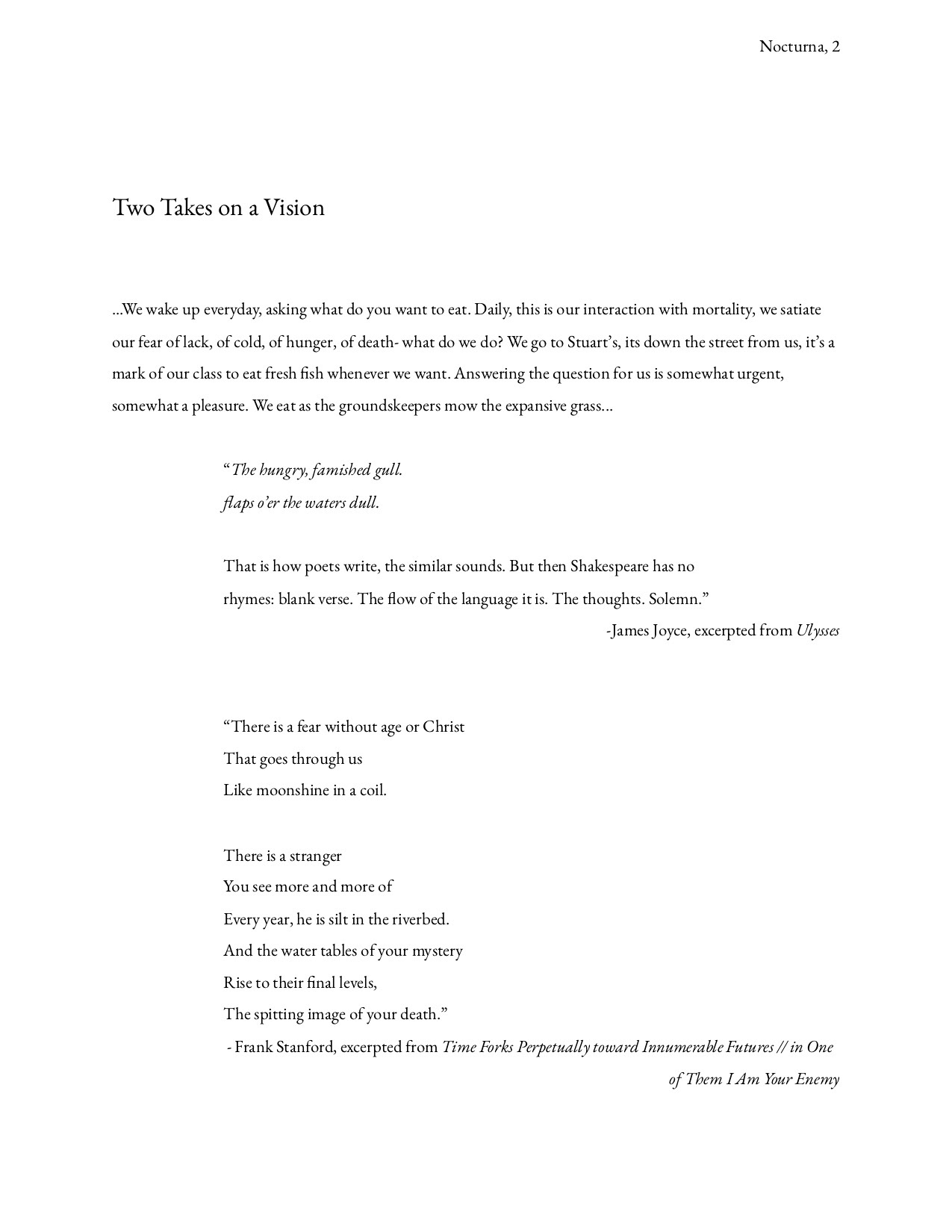
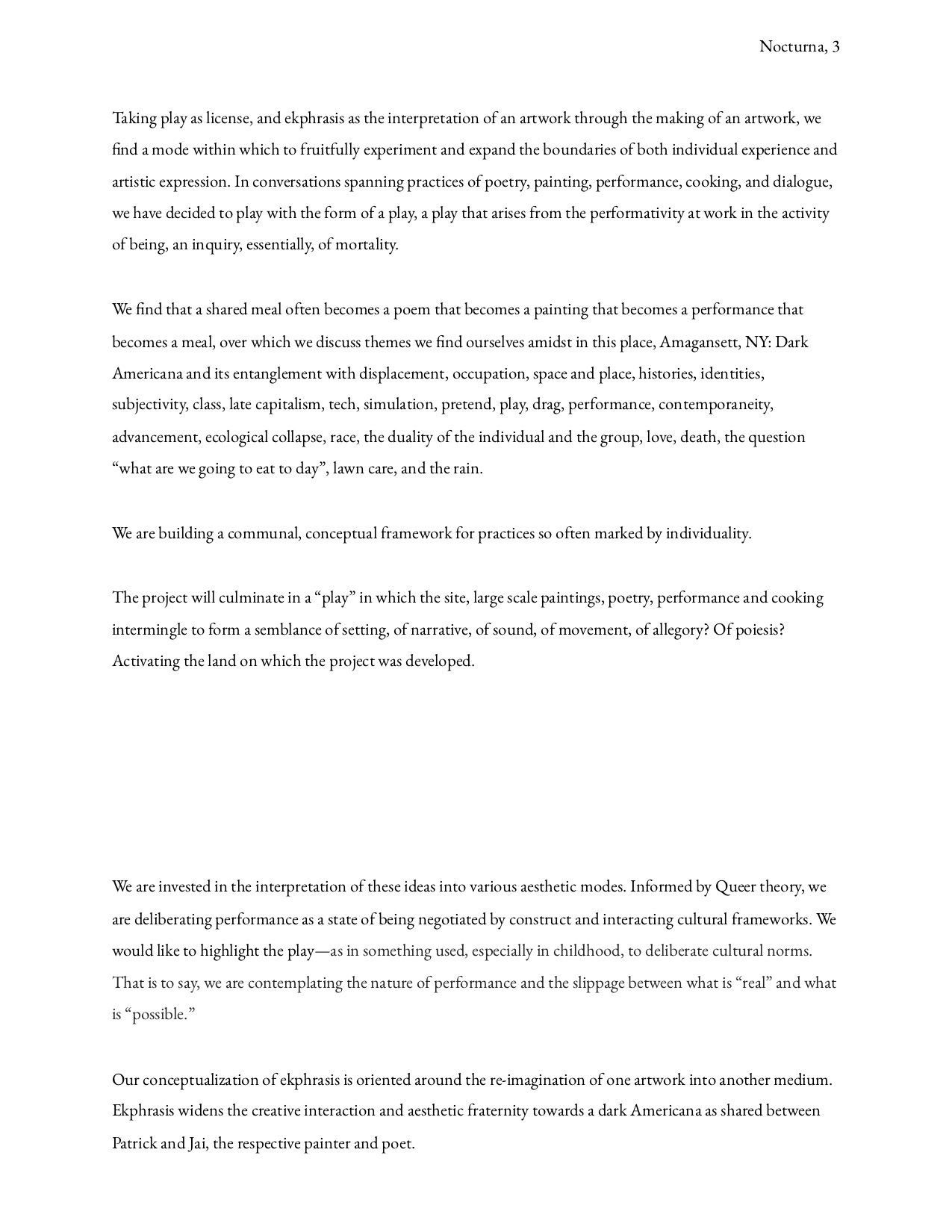
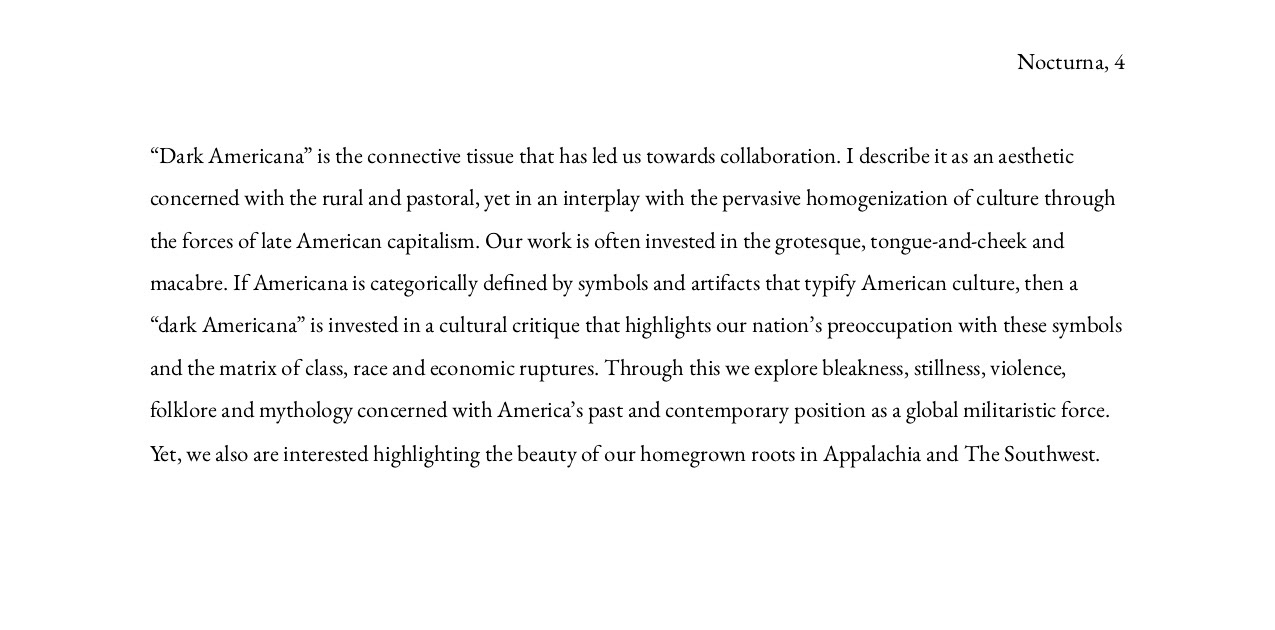
Excerpts from the invitation sent to collaborators. The document contained previews of the following paintings, a manuscript of Jai's poetry, an overview of the project, and quite a few quotations.
Big Beach Painting. Summer 2019. oil on canvas, unstretched. 84" x 234"
1st of 3 large scale paintings created as part of the "writing" of the "play".
The Hamptons. WIP photograph. Summer 2019. oil on canvas, unstretched. 96" x 264"
2nd of 3 large scale paintings created as part of the "writing" of the play. Blue Dark would go on to be overpainted during the course of the event.
Pearl Onions. Summer 2019. oil on canvas, unstretched. 96" x 149"
3rd of 3 large scale paintings created as part of the "writing" of the "play". Osiris burnt an offering of similar lamb chops during the denouement of the event.
Beau Rhee, Amr Sultan, Mar Robillard, Nayven Vallette, Farouk Oni, Caleb Milne, Daisy, and Eleanor Kipping (clockwise from left), circled around a diagrammatic score for the "Play" during rehearsal on the 27th of September, around midnight.
Thanks to all those who helped make this project happen, as well as all those who came to see it.
Dancers:
Jai Hamid Bashir -- Oracle, Poet
Amr Sultan -- Sound Design
Izzy Hogancamp -- Gallerist, Install team
Eleanor Kipping -- Director, Nocturna
Beau Rhee -- Choreographer, Painter, Draughtsperson, High Priestess
Patrick Bayly -- Painter
Megan Yuan -- Gallerist, Install Team, Painter
Farouk Oni -- Osiris
Stefani Eleoff -- Photographs, Install Team, the Hamptons Woman
Nayven Vallette -- Mic
Mar Robillard -- Photographer
Jesse Greenberg -- Singer, director at Hesse-Flatow, Install Team
Douglas Reiger and Dylan Languell -- Buried a Drum Set, Spirits
Caleb Milne -- Night Keeper
David Lenz -- Photography
Making Without Objects, from Columbia University:
Rirkrit Tiravanija
Cara Lynch
Eric Britain
Yi Sa Ra
Clare Koury
Stipan Tadic
Meredith Wilson
Henry Anker
Yushan Liu
Erin Elise Holland
Ashby Marie Bland
Georgica Pettus
Inga Mantica
Hosts:
Karen Flatow -- painter and proprietor of Hesse-Flatow and Crush Curatorial
Evan Flatow
Virginia Flatow
David Flatow
Shawn Flatow
and their respective families.
The following dialogue took place during a “rehearsal” for the “play,” in which we, through asking each other, are determining the form of the “play.” It has been edited and abbreviated.
We had been talking about parties used as marketing schemes, the Hong Kong protests [concurrent with this project in the summer of 2019], and deep-fake apps, when the recording began.
Jai: We privilege vision and sight as, like, the most akin-to-truth sense that we have, I think it’s really going to trouble that. And make us reimagine “what is perception?” Can we really trust what we see as non-mediated or mediated? It’s really interesting to talk to photographers specifically, where some might say “I am capturing life, truth.”
Beau: I love what you were saying, about sensory stuff too because this [gestures to her series of body-dance-trace drawings, Corporalities, on the floor of the studio] is also kind of strange, “what is body, or even smell” practice through methods that are non-hierarchical.
Jai: This fits really well with something I have been thinking about: is there a difference between feeling something mentally and feeling something internally? I hadn’t really configured [the question] in my practice before, what does it mean to feel a poem mentally or internally, not using the word bodily, using the word internally. I’ve been thinking of it in terms of this play, questioning what is real? One of the things I’ve been thinking about, coming from critical race and queer theories, where we are performing all the time, is questioning what is real. How are we occupying this place, that is not ours, in performing as “artists”, putting on this event? How do we play with it as simulacra? The Hamptons is like a Disneyland, its very Beaudrillardian. I’m thinking about how our performance can make fun/lampoon/observe that better, and how people can feel that internally.
Beau: I’m really interested in this mind-internal question. I write a lot for myself, and over the summer I put together a bunch of small poems, and I read some of your [Jai’s] work, and I was like, “These are like body poems.” I come from dance, its like when things are very deeply felt, but it’s not my mind, it’s a whole thing. I’m also interested in how you can like “sllrrrrp” a place. I don’t know, if i was going to the answer that prompt, it would be something non-rational. I feel like I would have to respond to that in a ‘here’ way [gestures towards the body], I can’t put it into words.
Jai: I love this, i was hoping it would go here. How do we perform power? I don’t know if we want to get actors. We wanted people to consider themselves performance artists. We wanted at one point to have people play archetypical roles, we are interested in myths and meaning making through myths, we wanted someone to come in and embody Nefertiti or Osiris.
We didn’t want to create a script. That’s where this feeling something mentally, or internally comes in. I’m just trying to connect all these dots.
Beau: No, because Nefertiti is already too loaded, its already like, “Oh my god, HISTORY. Phew, phew, phew."
Jai: What does it mean to “embody” versus “to play”? We wanted people to embody and play. I think simultaneously wanting both might mean that there is a difference. How do we feel some of the aesthetic modes that we’ve been thinking about, and how do we play with them?
Patrick: I’m thinking about your “non-rational response” in terms of that question. Like when you [motioning to Doug], were like “I want to put a boat motor in the pool, that flails wildly like an animal.” That’s the response, that’s how you engage with this, unsettle the water. What interests me about this project is reaching out to everyone, seeing that response I never would have thought of, and having this conversation through work — I gave you some stuff that I had written, some stuff Jai had written, and some paintings, and it comes to a boat motor in the pool.
Doug: I was thinking about bringing the Hamptons [as a] place to light, and doing something really rowdy, and my first thought was like, “I don’t know, I’ll set a big fire.” Then, “Well, let’s, like, back off from that.” And I’m still talking to Dylan about the boat motor thing. I like it a lot, but I don’t know, yet. The whole hierarchy about how to approach the space is really interesting, and we should really name our relationship to it. Are we going to be the free circus for Crush? Are we going to be the invaders of Crush? Are we going to be the pleasant party guests, are we going to be absolutely boring? Or just very strange?
Jai: One of my big questions is, how are we going to engage the audience? Are we going to interpolate the people that come as a formation of the performance itself?
Eleanor: I think you posed a really good question. We are doing a theatrical piece, and we’re also doing a performance, and I think it should be able to exist regardless of whether or not there is an audience in the space. If we have a five o’cock start time, we go until we feel, internally, that its done, whether we have 1 audience member or 1000. Obviously, their presence would alter the piece, we decide in what way.
Jai: Are you still think about inviting the audience to play characters?
Patrick: Yea.
Eleanor: Is this like a happening? I know a large part of it will be improv, but at some point we do need to make decisions to see something happen. But do you see this as a happening? Where there is no narrative, there is no character, there is no sort of through line? Or do you see it where there are these sort of characters, co-existing narratives, overlapping each other, in a free form way?
Patrick: I think I see it that way.
Eleanor: and that’s what I’ve imagined based on our conversations this year.
Beau: But I also think it would be cool, with a structure-thing, to have a very open score. Say there are 15 people, and each one has a question, and it could be one page, it doesn’t have to be set and timed. I’m just riffing off of you.
I’m actually really interested in embodying myth, too. I could do a character, or like.. I would be interested in doing something trace-like. I thought it would be cool to also have a formal link.
Patrick: If there was an art historical precedent, it would be the 1952 event at Black Mountain College. Merce Cunningham had people walk through the audience and collide with them, Rauschenberg sat on a ladder and yelled things occasionally, and Cage got up to play the piano, but didn’t play anything for four minutes. And Rauschenberg’s white paintings were just suspended from the ceiling. There are these 4 or 5 things that are happening formally that are set, that are colliding, with each other.
Eleanor: That’s what I imagined, there’s sort of an entry point, which is important, especially if we are talking about access, and power, as a gate. I don’t mind if there is an ending…orgasm, you know what I mean? I also like the idea of it happening at the same time, they both have benefits to weigh.
But I pictured there being like 4 locations, that people can interact with, that have roles and elements that we are directing across all of the spaces.
Beau: I also like this idea of party. Navigating this like a party, if it is going to be people coming in and going out, the space has that.. [gestures towards a volume of space].
Patrick: I like the party idea, too. The illogical response, I mean. Like, “Ah, I’ve got it, let’s cover ourselves with dry leaves and wax and dance around!” So maybe that could be a formal structure for this event, rather than the Cage event.
Beau: I think the next time we meet we need to draw up a score. Maybe not like literal, but like prompts or ideas.
Patrick: The last thing I want to pose before we break, is that we have been talking a lot about antagonizing the structures we’ve identified, which I want to see. But, Karen and I have also been talking about an idea of an “aesthetics of care,” which is like Assad Razza, who did a piece in the last Whitney Biennial and did a collaborative performance here last year. That’s something to think about too, in this direction. Maybe a more complicated reaction to all of this.
Eleanor: Can you send us the info on that?
….
Talking to Amr a few days later, about the mix he’s putting together for the event. We’ve talked about dissonance and anxiety, and he’s put together a guitar section.
Amr: I just want this part to be like we are going to beach, its all good.
Patrick: I’m really glad that you brought that in. That’s what it’s actually like to be there.
Amr: Yea, like making a straight up industrial house beat is how I connect with some of this anxiety. But, Yea, I mean focusing only on the negative is contrived. Like sure there are all these serious things happening here, but I would bet that even the people who are enchained in this system, this support system we talked about, feel this way when they are going to the beach. I think they would like it.
It’s like everything gets washed away.
Patrick: Like in global warming? These big houses getting washed away? Just messing with you.